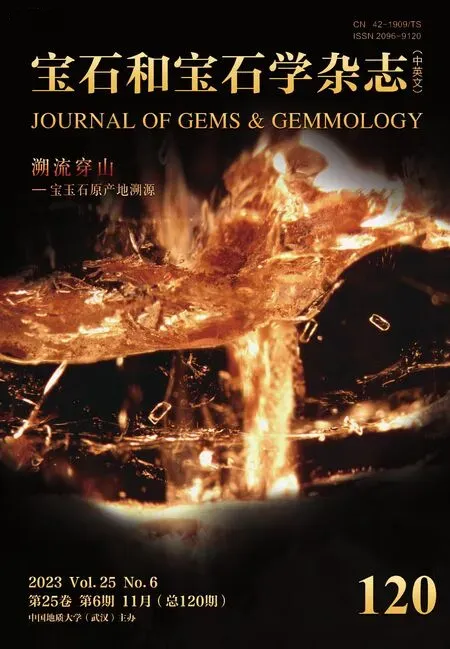Gemological-Mineralogical Characteristic of Spinels from Sri Lanka
Pantaree Lomthong,Dietmar Schwarz,Gamini Zoyza,Yanyu Chen,Yicen Liu
(1.Asian Institute of Gemological Sciences,Shenzhen 518038,China;2.Zmpery Gemology Lab.,Shanghai 201403,China;3.Ceylon Gemmological Services,Colombo 01400,Sri Lanka;4.Lab.of Gems &Technological Materials of Tongii University,Shanghai 200092,China)
Abstract:Detailed mineralogical and gemological records were conducted on 340 unheated spinels from the Horana,Eheliyagoda,Ratnapura,and Okkampatiya mining areas in Sri Lanka.The color of Sri Lankan spinel varies greatly:in addition to the mainstream pink to purple pink,green and blue can also be seen.Compared with spinel from other regions such as Myanmar,Vietnam,and Tanzania,Sri Lanka's spinel has more abundant inclusions:several mining areas generally have inclusions such as dolomite,apatite,zircon,and chondrodite.Minerals such as graphite and forsterite are also found in spinel produced in the Horana region; graphite and rutile have been found in spinel produced in the Okkamptiya region.Partially healed fissures are most common in spinel in the Okkampatiya mining area; Unlike Vietnamese spinel,dislocations and growth structures are almost absent in Sri Lankan spinel.The LA-ICP-MS analysis results showed that there were no significant differences among the mining areas.LA-ICP-MS analysis of 5 Sri Lankan cobalt blue spinels showed a variation of 11 to 120 ppm in this chromogenic element.The UV visible absorption spectrum results show that Sri Lankan spinel has a combination spectra with variable ratios of the spectral components Cr3+,V3+ and Fe2+ from pink to red,orange,purple to purple,and blue-green.The results of infrared spectroscopy and laser Raman spectroscopy analysis showed that all samples showed no indications for heat treatment.
Keywords:gemological-mineralogical characteristic; spinel; Sri Lanka; spectroscopy; inclusion
MINERALOGY AND CRYSTALLOGRAPHY ASPECTS
Natural magnesium-aluminum spinel (MgAl2O4) as a gemstone is known in a wide range of colors.Most appreciated are red spinels,but pink to purple and blue are also favorites.Spinel is a term used to describe a wide variety of compounds with the same crystal structure.Gem-quality spinels are almost pure MgAl2O4end-members with zinc,chromium and iron present,not exceeding 0.05 atom per formula unit (Malsy &Klemm,2010).
“Normal” spinel is usually represented by the formula AB2O4,where the A ions are on tetrahedrally coordinated sites and the B ions are on octahedrally coordinated sites (Fig.1).“Invert” spinel is also known,and can be described as B(AB) O4.In this case,the B ions are on both sites and the A ions are on the octahedral site.Any intermediate combination of normal and invert spinel is usually described as “disordered.” Most gem spinels are primarily of the normal spinel MgAl2O4type.The “ordered” spinels can often be disordered by heating,and thus disorder might be used as criteria to determine if the stone has been heated (Saeseaw et al.,2009).

Fig.1 Crystal structure of ordered spinel (Kefeni &Mamba,2019)
GEOLOGY AND GENETIC ASPECTS
The global distribution of spinel deposits is closely linked to collision,rift,and subduction geodynamics.Two main periods of spinel formation are recognized:[1]The Pan-African orogeny (750-450 Ma) and[2]The Himalayan orogeny (45 to 5 Ma).The deposits formed during the Pan-African orogeny are located in Tanzania (Umba,Mahenge-Morogoro,Tunduru),Kenya (Voi region),Madagascar (Ilakaka,Liolava/Bekily),and in Sri Lanka (various locations in the Highland Complex).The much younger deposits formed during the Himalayan Orogeny are situated in the so-called “SE-Asian Ruby Belt” and include Myanmar,Afghanistan/Tajikistan (“Badakhshan”),Pakistan and Vietnam.
Spinel deposits located in marbles or in neighboring pelitic gneisses are widely known as sources of gem-quality material——e.g.in Myanmar (Mogok and Namyazeik),Vietnam (Luc Yen),Afghanistan/Tajikistan (Pamir Mountains) and Tanzania (Mahenge).The formation of these deposits is explained by:(1) metamorphism of limestones primarily contaminated by aluminous products of weathering; (2) metasomatic trans-formations of terregenous layers in marbles by metamorphic solutions; and (3) influx of Al into marbles by endogenic solutions related to alkalic magmatism (Fernando et al.,2005).
There is an intimate relationship regarding the formation of ruby and spinel in marble-type host rocks.Several reactions are involved in the formation of ruby in marbles.The principal reaction is the destabilization of spinel in contact with calcite during the retrograde metamorphic path (e.g.Jegdalek in Afghanistan,Hunza in Pakistan and Luc Yen in Vietnam).
The chemistry of fluid inclusions trapped in gem ruby indicates that most of the gemstones crystallized from spinel as this reaction uses up CO2.Thermodynamic conditions,such as the presence of high CO2fugacity for ruby formation,are favorable for spinel breakdown (Garnier et al.,2008).
[spinel,MgAl2O4]+[calcite,CaCO3]+[CO2]→[corundum,Al2O3]+[dolomite,CaMg(CO3)2]
Ruby in equilibrium with dolomite forms from the reaction of spinel with calcite:Spinel is a pre-ruby phase and its mineral chemistry shows high Cr and Zn contents.The source of chromium for ruby in that case is most likely spinel.Primary gemstone deposits are common in the Precambrian basement rocks of Sri Lanka.The Sri Lanka Precambrian rocks were metamorphosed under the granulite facies,but they now are neither uniform nor homogeneous,since most of them underwent retro-metamorphism during late Archaean under conditions that were locally different.
Corundum,zircon and spinel are mined in the so-called Highland Complex.In the Elahera district (Bakamuna Zone),the mother rock is a skarn body that formed at the contact between a pegmatite dyke and marbles.The inner pegmatite zone is sterile and the intermediate zone contains fine-grained spinel and scapolite aggregates with occasional corundum and phlogopite.The outer zone,although similar in composition to the intermediate one,is coarse-grained and contains porphyroblasts of corundum and spinel.Spinel makes up to 70% of the 20-30 cm wide wall rocks in contact with the marble (Gorghinian et al.,2013).
Such deposits can be interpreted as (a) exo-skarn formations that are a product of metasomatic solutions migrating from the pegmatite into the marbles,or (b) endo-skarns with the de-silication of the pegmatite because of carbonate contamination from the marbles.Spinel growth is considered to occur during a late-metamorphic stage,together with some corundum and phlogopite (Gorghinian et al.,2013 and papers cited therein).
According to Fernando and Hofmeister (2000) and Fernando et al.(2005),in the corundum-spinel-taaffeite-scheelite bearing metasomatites in Bakamuna and Rupaha,spinel and other gem mineral-bearing lenses and pockets are found in a reaction zone developed between marbles and pelitic gneisses.The reaction zone represents the transformation of the host marble to Al-rich pelitic gneisses.
Kriegsman and Schumacher (1999) report the presence of spinel in sapphirine-bearing and associated granulites in central Sri Lanka (Hakurutale and Munwatte localities).Giuliani et al.(2017) state that the mineralogical and physical properties of gem spinels found in secondary deposits (i.e.placers) in Madagascar (Ilakaka) and in Sri Lanka,up until now were not sufficiently precise to decipher their primary deposits.
Today,the most important spinel mining sites in Sri Lanka are:Ratnapura,Eheliyagoda/Pelmadulla/Balangoda (which produce all colors,including “cobalt blue” and star stones); Okkampitiya (green,bluish green,pink,purple); Elahera (pink,purple); and Horana (all colors).
SAMPLES AND ANALYSIS METHODS
More than 340 unheated faceted (mostly of gem quality) stones,ranging from 0.06 to 4.05 carats,and 74 polished crystals were fully documented for this study.They originate from the following mining areas:Horana (183 samples),Eheliyagoda (86 samples),Ratnapura (38 samples) and Okkampitiya (113 samples).They are all located in the so-called Highland Complex.
The mineralogical-gemological documentation of the samples included UV-Vis-NIR spectroscopy,FTIR spectroscopy,Raman spectroscopy (detection of heat treatment),chemical fingerprinting (using EDXRF and LA-ICP-MS) and the study of the internal features (using gem microscope and Raman microspectroscopy for the identification of solid inclusions).
The color of the analyzed spinels typically varied from pink-to-red,orange,purple-to-violet with some green-to-blue stones.Also included in the study were several cobalt-blue spinels from unspecified locations in Sri Lanka.
INTERNAL FEATURES
The gemological properties (especially the internal features) of spinels have been discussed in many papers (e.g.Gübelin and Koivula,1986,2005; Malsy and Klemm,2010; Huong et al.,2012; Phyo et al.,2019).Probably the most common and most specific inclusion types in gem-quality spinels from different geographic locations are the so-called “octahedral inclusions”.In 1976,Webster described small negative (hollow cavities having a crystal outline) or solid inclusions of octahedral forms as common inclusions in spinels.These may be spinel crystals or crystals of other members of the spinel family (e.g.magnetite).These octahedral crystals may be grouped in densely parallel rows,which are often oriented to definite crystallographic directions in the host crystal.The same author states that films that often containing iron staining and commonly associated with large octahedral crystals are common spinel inclusions.Ceylon spinels usually show “zircon halos”,a central inclusion surrounded with brown stain markings that may appear like wings.
Gübelin and Koivula (1986,2005) indicate that the most obvious and reliable characteristics of spinel are hoards of parallel “strings” of minute octahedra filled with either a white or black substance.The black octahedra represent one of those rare examples of syntaxial intergrowth.They are spinel crystallites of similar chemical composition,e.g.preferably hercynite,although ceylonite (pleonaste),gahnite,magnetite,and picotite could be other possible varieties.White “octahedra” were vacated either in great masses or in small quantities simultaneously with the growing spinel,or else they were exsolved as solid sub-components during the slow cooling of a high-temperature mixed crystal.Spinel favors the formation of numerous octahedral,negative crystals,yet empty and hence transparent ones are extremely rare.In most spinels,they are in-filled with white dolomite or some other mineral substances (e.g.calcite and brownish ankerite; yellow phlogopite; black hercynite; grayish graphite).
The dolomite-filled octahedral negative crystals constitute a most common internal accent of spinel from most of the known sources.Mineral filling substances described in the negative crystals of Sri Lanka spinels are ankerite,högbomite and phlogopite (Gübelin and Koivula,2005).
Henn (2013) mentions the following inclusion features in natural spinels.Black or white octahedral inclusions.The black octahedra are hercynite crystals (FeAl2O4).The white (partly transparent) octahedra are negative crystals,which are filled with crypto-crystalline dolomite or calcite.Typical are arrangements of small octahedra that are reminiscent of strings of pearls.
Based on our observations of Sri Lankan spinels,we propose different “types of octahedral inclusions”:(1) crystals that belong to the spinel group (e.g.black-opaque hercynite; col-orless-transparent “sensu strictu spinel”); (2)“void” cavities or cavities whose internal walls are lined (coated) with foreign mineral substance (e.g.carbonate); (3) cavities in the form of negative crystals that contain a fluid filling; (4) cavities that are filled with a crypto-crystalline mineral substance; the nature of the filling material depends on the nature of the spinel host rock.Under the gem microscope,it is often difficult (or even impossible) to distinguish the different “octahedral types,” especially when these inclusions are small.On partially healed fissure planes,different types of octahedral inclusions may be present at the same time.It can be supposed that,at least in part,these contain “classic” fluid fillings.
The octahedra occur as single (isolated) “primary crystals/negative crystals” of variable size,or they are dispersed on healed fissure planes as “secondary negative crystals”.On fissure planes,“octahedral inclusions” may display an irregular distribution,or are arranged in straight or slightly curved strings.Quite often,the octahedra are disposed in geometric formations that result in the so-called “spinel pattern”.
For the documentation of the internal features of the spinels examined in this study,the inclusion scenarios are described using the following inclusion types:(1) solid inclusions; (2)partially healed fissures; (3) “cavities” (negative crystals; octahedron-like inclusions); (4) stringer-like formations; (5) dislocation systems; (6) twin lamellae; (7) accretion clouds and aureoles and (8) growth structures.
Inclusions
The most interesting inclusion type in the internal world of spinels is the large group of solid inclusions.A huge variety of mineral inclusions (representing the internal mineral association) has been identified.These reflect the nature of the external mineral associations in which spinels have formed in different metamorphic genetic environments.
Gübelin and Koivula (1986,2005) identified a large number of inclusion minerals in Sri Lankan spinels (of variable color) using one or more analytical methods:albite; apatite (well-formed,hexagonal-prismatic,syngenetic crystals or corroded protogenetic crystals); feldspar (elongated,colorless crystals; cross-and star-like arrangements); forsterite (protogenetic formation; transparent,± idiomorphic crystals); graphite (black-opaque,hexagonal platelets,often arranged along octahedral planes; flake-like crystals); hematite (in color-causing sheets going back to exsolution; red crystals); hercynite (black octahedra with metallic luster; tiny exsolved octahedral crystals aligned along irregular rows; dark cloudy masses); limonite (epigenetic formation); phlogopite (brownish red,lath-like crystals); pyrrhotite (protogenetic crystals showing metallic luster); pyrite (often crystals with wrinkled surface texture); quartz; rutile (ultrafine particles and needles; hair-fine golden fibers; black crystals accommodated in irregular cavities); sillimanite (white crystals); sphene (semitransparent fan-and lath-like crystals); spinel (slightly corroded crystals); uraninite (black grains,often accompanied by a circular stress halo or by systems of stress fractures); zircon (metamict with stress halos).These authors describe the carbonates dolomite (clear) and calcite (striped as a result of cleavage planes) as inter-grown mineral fillers in “white” octahedra; in addition,dark-grey graphite may be present.
Kleismantas et al.(2017) indicated the following inclusion minerals in Sri Lanka spinels (using a scanning electron microscope):biotite,paragonite,clinochlorite,pyrite,diopside,and florensite[CeAl3(PO4)2(OH)6].
RatnapuraSpinels
In Ratnapura spinels documented for this study,different types of colorless-transparent inclusion minerals were observed.Using Raman Microspectroscopy,the following mineral inclusions were identified:dolomite + calcite,chondrodite,apatite and zircon.

Chondrodite.Chondrodite is a nesosilicate mineral and member of the humite group minerals (Mg,Fe2+)5(SiO4)2(F,OH)2),is the second most frequent solid inclusion in spinels from the Ratnapura mining area.Chondodite is a fairly rare mineral,formed in hydrothermal deposits from locally metamorphosed dolomite.It is also found associated with skarn and serpentinite.
It typically occurs in slightly flattened crystals and frequently in rounded grains.Chondrodite inclusions are nearly colorless and occur generally as irregularly rounded crystals of variable size.
Apatite.Apatite inclusions display a wide range of shapes and probably,this inclusion mineral is present in two “generations”:(a) Protogenetic crystals are rounded-elongated and oriented in different directions,and (b) syngenetic apatite shows well-developed,short-prismatic crystals with many faces that have strong contours in the host spinel.
Zircon.Zircon inclusions are present in the form of small,irregularly rounded (grain-like) crystals,or as elongated-prismatic shapes.The zircon inclusions occur single or they form cluster-like agglomerations.In part,the zircons are accompanied by small,delicate tension/partially healed fissures.
Besides this,tiny,colorless,needle-or rod-like crystals and grayish white,irregularly shaped (angular) crystals of unknown nature were observed in Ratnapura spinels.
The mineral inclusions are often accompanied by large,±planar partially-healed fissures.They are composed of isolated,irregularly shaped,angular (sometimes octahedron-like) cavities/fluid inclusions.In part,these are arranged in curved,nearly parallel bands/lines.
HoranaSpinels
Spinels from the Horana mining area display the largest variation of mineral inclusions observed in samples from the four locations examined for this study.The most frequent in-clusion mineral is dolomite,which displays a wide range of crystal shapes (from irregularly rounded to well-developed rhombohedron-like).Dolomite is also present as a “filler mineral” in octahedron-like negative crystals.
In secondary cavities accommodated on partially healed fissure planes,dolomite was identified together with CO2,indicating the presence of a fluid filling in these cavities.The carbonate minerals calcite,magnesite/rhodochrosite and aragonite were very rarely found in Horana spinels.
Apatite.Apatite is a common inclusion mineral in spinels from different locations/genetic environments.In spinels from Horana,most apatites show irregularly rounded to elongated shapes.
Zircon.Zircon inclusions are present in the form of colorless-transparent crystals that display strong contours in the host spinel.These crystals are of variable size.Mostly,they are irregularly shaped (elongated,angular or slightly rounded),although rarely,they have well-developed,prismatic shapes.When cut at the surface,they show a high reflectivity.
Rutile.Rutile forms black-opaque,elongated to short-prismatic crystals that are oriented in different directions.
Gübelin and Koivula (2005) describe protogenetic forsterite inclusions in a spinel from Sri Lanka.This mineral was found as an inclusion in one of our spinels from the Horana mining area.It is present as an “agglomeration” with many colorless-transparent,irregularly rounded (mostly elongated) crystals that are oriented in different directions.They are of protogenetic nature.
Forsterite.Forsterite[Mg2SiO4]is the magnesium-rich end-member of the olivine solid solution series.Forsterite occurs in dolomitic marble,which results from the metamorphism of high magnesium limestones and dolomites.The progressive metamorphism between dolomite and quartz forms forsterite,calcite and carbon dioxide is shown below:

Spinel.The spinel crystals display a well-developed (octahedral),colorless-transparent structure (Fig.2a).
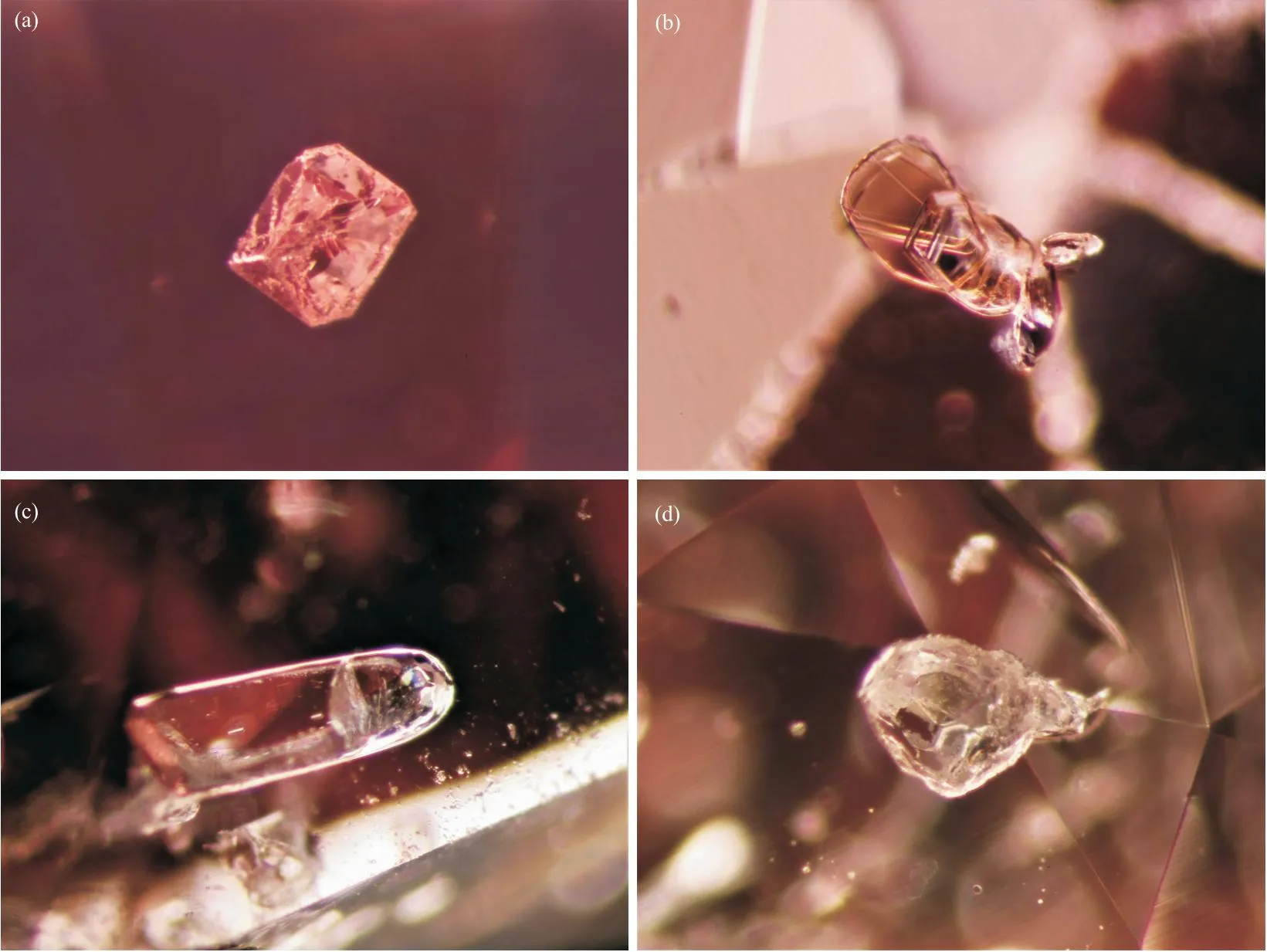
Fig.2 (a) Well-developed (octahedral),colorless-transparent spinel crystal hosted by a Horana spinel; (b) Orangey-brown,transparent,irregular-rounded crystal of unknown natural hosted by a Horana spinel; (c)Colorless-transparent,elongated-prismatic,rounded apatite crystal; (d)Colorless-transparent irregular rounded dolomite crystal.
Graphites.Graphites are black-opaque,plate-like crystals,of variable shape (often showing well-developed,six-sided outlines).The platelets are mostly concentrated on “growth planes”,and do not show any preferred orientation in the host spinel.When using fiber optics illumination,the platelets become highly reflective and display a strong (sub-)metallic luster.In part,the platelets are associated (surrounded) by flattened cavities and/or small,unhealed-reflective tension fissures and tiny,isolated,drop-like cavities/fluid inclusions.
Chondrodite.Chondrodite is found in one of the Horana spinels.The magnesium iron silicate,chondrodite inclusions are colorless-transparent,well-developed,tabular or irregular shaped angular crystals.
The following mineral inclusions observed in Horana spinels have not been identified so far:(a) Slightly yellowish brown,transparent,irregularly shaped (angular) crystals of variable size that have a high relief in the spinel host; in part,short,very delicate,tube-/needle-like inclusions are “attached” to the surface of these crystals.(b) Large,elongated,crystals with many (mostly slightly rounded) faces.(c) Slightly brownish,plate-like,irregular-angular (slightly rounded) crystals.These are oriented in different directions.(d) Plate-like crystals that have square-like shapes.(e) Orangey-brown,transparent,irregular-rounded crystals of an unknown nature.
The mineral inclusions in Horana spinels are often accompanied by disk-like,highly reflective (mirror-like) tension fissures that are oriented in different directions.
OkkampitiyaSpinels
In Okkampitiya spinels,Gübelin and Koivula (2005) described two “generations” of apatite inclusions in spinel:(a) strongly resorbed protogenetic crystals and (b) accumulation of euhedral syngenetic crystals.In our samples from the Okkampitiya mining area,apatite is a common inclusion with colorless-transparent,irregularly rounded to elongated (protogenetic) crystals of variable size (Fig.2c).
Dolomite.Dolomite is the most common inclusion mineral in Okkampitiya spinels.It is present as isolated (single) crystals that mostly display angular rhombohedron-like crystals of variable size,and as filler mineral in negative crystals.
Calcite.Calcite is a rare mineral inclusion,and is mainly present as filler mineral in negative crystals.
Quartz.Quartz (colorless-transparent,irregularly shaped crystals) is a very rare inclusion mineral in spinels from Okkampitiya.
Zircon.Zircon inclusions are generally present as colorless-transparent,irregularly rounded (grain-like) crystals.
Rutile.Rutile was found in small,irregular-angular crystals or in “swarms/clouds” with innumerable very delicate and very short,reflective-iridescent,needle-like inclusions that are oriented in different directions (rare).
Graphite.Graphite exhibits very small,six-sided,black-opaque platelets showing an intense “metallic” luster when using fiber optics illumination.
Rarely seen were irregularly rounded,opaque crystals that display a brass-like,metallic luster (probably representing a sulfide mineral).Very common are black-opaque,plate-or grain-like,irregularly rounded crystals,which are oriented in different directions and display an intense (sub)metallic luster when using fiber optics illumination.Black-opaque,grain-or plate crystals may be attached to cavity walls of negative crystals (inside and/or at the surface).The nature of these inclusions has not been identified so far,but they may represent the minerals rutile and/or hercynite and pyrrhotite.
In part,these inclusions are accompanied (surrounded) by very delicate,grayish seams.The black grains/platelets may be accompanied by small,reflective (under fiber-optics illumination),wing-like and/or planar (disk-like) tension fissures.
Colorless-transparent crystals have not yet identified in Okkampitiya spinels,and belong to different mineral species:(a1) Plate-like,irregularly rounded crystals that are oriented in different directions; (a2) six-sided,highly reflective (mirror-like) plate-like crystals; (b) slightly yellowish,transparent,elongated-rounded crystals that have very low contours in the host spinel; and (c) irregular-angular crystals with slightly rounded faces.
Rarely seen in Okkampitiya spinels are extremely fine-grained,grayish,±parallel bands (diffuse) or cloud-like formations,which are composed of innumerable tiny,grayish pinpoint inclusions and very short and very delicate,reflective-iridescent (under fiber optics illumination) needle-like inclusions.The needles are oriented in different directions and show a rutile-like aspect.The presence of bands and clouds is restricted to certain “domains” in the host crystal.They may result in a slightly milky appearance of the host spinel.
EheliyagodaSpinels
Solid inclusions (crystals or crystal fragments) are less common in Eheliyagoda spinels than in stones from the other mining areas documented for this study.Nearly all mineral inclusions are colorless-transparent,although they display a large variation in size,shape and the strength/intensity of the contours in the host spinel.When the inclusions are small,it becomes very difficult to separate colorless crystals and angular (especially octahedron-like) cavities (negative crystals) under the microscope.
The following “types” of colorless-transparent crystals (that represent different mineral species) have been observed:(a) irregularly shaped (mostly small) zircon grains; (b) slightly rounded,rhombohedron-like crystals showing a strong relief in the spinel host (dolomite,Fig.2d); (c) elongated,slightly rounded (apatite); not identified were (d) small,irregularly rounded crystals showing weak contours; and (e) well-developed,long-prismatic crystals.
The mineral inclusions,as well as isolated (single) cavities/fluid inclusions,are often accompanied by different types of fissures:(1) Tiny,delicate tension fissures that are oriented in different directions; (2) ±planar (disk-like) tension fissures with poorly developed healing textures and,depending on the lighting conditions,these fissures are reflective (mirror-like) or they show a frosted appearance; (3) rarely seen are planar (disk-like) tension fissures that display an atoll-like aspect.Crystals (and negative crystals) may be are accompanied by delicate,grayish,dust-like formations.
The presence of (protogenetic) forsterite crystals in spinels from the Horana mining areas,as well as the presence of chondrodite in Ratnapura,Horana and Okkampitiya spinels,supports the genetic model relating the formation of spinels in the Sri Lankan Highland Complex to reactions between marbles and pelitic gneisses or marbles and pegmatites that result in skarn bodies.
Table 1 presents an overview of the mineral inclusions identified by various authors regarding Sri Lankan spinel from different locations.

Table 1 Overview of the mineral inclusions regarding Sir Lanka spinels from different location
PartiallyHealedFissures(“SecondaryFluidInclusions”)
According to Gübelin and Koivula (2005),partially healed fissures with typical “fingerprint” patterns rarely occur in spinels and are consequently of no particular significance in the determination of locality.Yet,when they are present,they display pretty designs of their fluid droplets and sometimes they reflect vivid interference colors.
Partially healed fissures are most common in the examined spinels from the Okkampitiya mining area.These display also the largest variation in partially healed fissures regarding size,orientation and healing patterns.In general,the partially healed fissures are nearly planar and do not have a preferred orientation in the host spinel.Sometimes,they are oriented nearly parallel to each other and form bizarre arrangements.Delicate fissures may be arranged in swarm-like systems that are oriented in different directions.Fissures that belong to the same “system” run parallel to each other.Many partially healed fissures show elongated,lath-like shapes.
In Okkampitiya spinels,the following “fissure types” can be distinguished:(a) Partially healed fissures with coarse textures showing typical,fingerprint or network-like,reflective patterns (rare,Fig.3a); (b) other fissures composed of isolated,angular-elongated (slightly rounded),flat cavities of variable size,although these fissure constituents are mostly small,resulting in a transparent to grayish-frosted appearance (reflective-iridescent when using fiber optics illumination); (c) very common are coarse textures with innumerable,isolated,irregular-angular (often octahedron-like) cavities of variable size and larger cavities may show irregular-bizarre shapes.Normally,the cavities show an irregular distribution on the fissure planes.Rarely,they form string-like arrangements.In general,the cavities contain some foreign material (e.g.colorless-transparent to grayish-frosted mineral substance and/or tiny,black-opaque grains/platelets).In part,the octahedra are accompanied by short,very delicate,needle-or tube-like inclusions or by small,grayish-frosted tension fissures; (d) also present are very delicate,veil-like partially healed fissures composed of tiny,isolated,drop-like constituents (rare).

Fig.3 (a)Partially healed fissure with coarse textures,these mostly composed of isolated/elongated (tube-like) constituents.Typical network-or fingerprint-like patterns are not developed; (b)Partially healed fissure showing the typical spinel pattern.This is composed of innumerable,grayish white,octahedron-like cavities (“negative crystals”).They are arranged in parallel strings that are oriented in different directions.Many cavities are accompanied by tiny tension fissures that are oriented parallel to each other.
A special variation of Type (c) are partially healed fissures that display the so-called “spinel pattern”.This is composed of innumerable,slightly rounded (drop-like),irregularly shaped or well-developed,octahedron-like,secondary cavities of variable size (mostly small).
The cavities are arranged in straight or slightly curved “strings” of variable length.The “strings” are oriented in different directions,forming “swarms”.Strings belonging to the same swarm run ± parallel to each other to form in part,geometric arrangements.The (secondary) cavities may be accompanied by tiny,planar (disk-like) tension fissures that are oriented nearly parallel to each other.Many cavities are surrounded by small,very delicate,grayish,cloud-or flake-like formations (“aureoles”).
In Ratnapura spinels,most partially healed fissures show only poorly developed textures.In general,typical networks or fingerprint-like patterns are not developed.Many fissures contain irregularly shaped,frosted areas.Partially healed fissures are mainly composed of isolated,irregularly rounded or irregularly shaped (angular) cavities of variable size.
In part,the cavities are accompanied by very short,delicate needles/tubes that are oriented in different directions.Other cavities are accompanied by small,delicate,planar (disk-like) tension fissures,which are also oriented in different directions (Fig.3b).
Very common are partially healed fissures containing isolated,octahedron-like negative crystals of variable size,and in part,the cavities are arranged in straight “lines”.Cavities are sometimes accompanied by a delicate,grayish white“halo” composed of tiny pinpoints/particles.Fissures displaying the typical “spinel pattern” are rare in spinels from the Ratnapura mining area.
Unhealed fissures are reflective (often showing a mirror-like aspect) or they contain grayish-brownish staining material (this may result in a frosted appearance).In Eheliyagoda spinels,partly healed fissures with poorly developed “classic” textures are common.This means no typical fingerprint-or network-like patterns are present.Instead,the healing textures can be generally described as“spinel pattern”.
In the Horana mining area,partially healed fissures with coarse,fingerprint-like textures are rarely observed in spinels.More common is the typical “spinel pattern” known in spinels originating from different geographic locations (and different geologic-genetic environments).
“Cavities” (NegativeCrystals,Octahedron-LikeInclusions)
The octahedron-like inclusions were described by Malsy and Klemm (2010) as “octahedral negative crystals” in spinel from the Himalaya region.These are transparent or with a turbid white aspect and partly filled by calcite and/or dolomite substance (Fig.4a).They are generally lined up in rows,occasionally accompanied by equatorial stress fissures.Sometimes,they are penetrated by a needle-like crystal.The “octahedra” occur isolated (single) or in the form of swarm-like arrangements (Fig.4b).Sometimes,they are arranged on parallel “growth planes.”

Fig.4 (a) Well-developed,colorless-transparent,octahedron-like negative crystals; (b)Swarm of irregular shaped cavities (negative crystals)accompanied by planar,partially healed fissures; (c) Very common in Okkampitiya spinels are irregularly shaped (often bizarre-looking) cavities,accompanied by unhealed-frosted or poorly healed fissures.These cavities often contain a polycrystalline minerals substance.Also present are small,black-opaque platelets/grains.
Two types of cavities can be distinguished:(a) Primary cavities that are generally present as isolated (single),irregularly shaped (angular) to well-developed,octahedron-like cavities (= negative crystals) of variable size.Rarely observed are colorless-transparent,irregularly rounded cavities with many poorly developed faces.Depending on the lighting conditions,the cavities appear colorless-transparent to grayish-frosted (highly reflective under fiber optics illumination).Sometimes,they are arranged in swarm-like or in straight,stringer-like formations that are oriented ±parallel to each other.The primary cavities may form bizarre arrangements when associated with reflective or frosted formations (depending on the lighting conditions).(b) Secondary cavities that are developed on partially healed fissure planes.These are mostly irregularly shaped (angular) or have well-developed,octahedron-like shapes of variable size.In part,the cavities are arranged in straight or curved,stringer-like formations that are oriented ± parallel to each other.Very common in spinels from different locations/genetic environments is the “spinel pattern” (geometric arrangements of the secondary cavities,Fig.4c).
In Okkampitiya spinels,the octahedron cavities are often associated with small,black-opaque,grain-or plate-like crystals (pyrrhotite; graphite),which are attached to the cavity walls (at the surface and/or inside the cavity wall).In general,the octahedra are accompanied by one or several small,wing-like,reflective tension fissures.In part,the octahedra are associated with short,delicate tubes/needles that are oriented ±perpendicular to the cavity walls.
In Horana spinels,the octahedron inclusions are very common.Mostly,these cavities are accompanied by ±planar (sometimes,disk--like) tension/partially healed fissures that are oriented in different directions.The partially healed fissures are composed of tiny,isolated,drop-like constituents,which,in general,show an irregular distribution on the fissure planes.Geometric patterns are indicated only rarely.
Other cavities are accompanied by unhealed-reflective (often mirror-like) tension fissures or by fissures with poorly developed healing textures (à frosted appearance).Very rarely,the cavities are surrounded by cloud-like halos that are composed of grayish white pinpoint inclusions.Malsy and Klemm (2010) described these halos as “accretion clouds that are composed of minute light scattering particles encircling the negative crystals”.
In Ratnapura and Eheliyagoda spinels,the octahedra are also quite common.These occur isolated (single) or are arranged in groups (swarms).Most octahedra are accompanied by isolated,drop-like,reflective cavities,which are arranged in loose “clouds” or in planar formations (probably healed fissures).Some octahedra are accompanied by small,planar,highly reflective (mirror-like) tension fissures.
Stringer-LikeFormations
In Okkampitiya spinels,stringer-like formations are a common inclusion feature.They are composed of tiny,grayish pinpoint inclusions and reflective particles (Fig.5a),more rarely of very delicate,colorless-transparent,flat cavities or plate-like (negative?) crystals (Fig.5b).When using fiber optics illumination,they become highly reflective.The stringers are generally delicate,straight or slightly curved and of variable length.They are normally oriented in different directions.Stringers may occur in swarms,forming lath-like arrangements.The swarms are oriented in different directions.Stringers of the same swarm run parallel to each other.A high concentration of stringer-like formations (together with delicate partially healed fissures) may result in a slightly milky appearance of the host spinel.
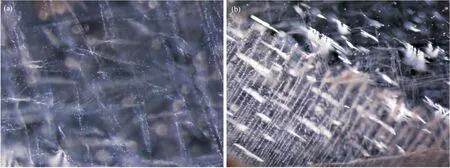
Fig.5 (a) Stringer-like formations are a common inclusion feature in Okkampitiya spinels.They are composed of tiny,grayish pinpoint inclusions and reflective particles; (b) Stringer-like formations are straight and oriented nearly parallel to each other.Also present are delicate planar,highly reflective tension fissures that are oriented parallel to each other and perpendicular to the strings.
Stringer-like formations were rarely seen in spinels from the Ratnapura and Eheliyagoda mining areas,and were not observed in Horana spinels.
DislocationSystem
According to Malsy and Klemm (2010),this inclusion type is quite common in spinels from Vietnam.It was described by these authors as “dislocation channels,bands or stellate networks that go out from fluid inclusions with cut-off by growth steps”.Dislocation systems are intersecting bands of iridescent,parallel oriented channels or building three-dimensional stellate networks.Single bands with distinct cut-offs can be observed and are most probably generated by bisecting growth steps.
Stellate dislocation systems in Vietnamese spinels appear to have developed from centrally located inclusions,which appear to be fluid in nature.Small,primary two-phase fluid inclusions are situated at the intersection or hub of a stellate dislocation pattern (Gübelin and Koivula,2005).
In the large amount of Sri Lanka spinels examined for this study,dislocation systems were observed only in very few samples.
TwinLamellae
Indications of cubic and octahedral polysynthetic twinning are rarely seen in Sri Lanka spinels (Gübelin and Koivula,2005).In the spinels examined for this study,twin planes have been seen in very few samples.
AccretionClouds/Aureoles
As mentioned before,the most specific inclusions in spinels originating from different geographic locations and different geological-genetic environments are the (generally octahedron-like) negative crystals.These are present as primary and secondary cavities of variable size.Almost always,the “octahedra” are accompanied by or are associated with other inclusion features.
The most frequent companions of the octahedra are different types of fissures:(a) Unhealed (dry) tension fissures,which are planar (often disk-like with mirror-effect) and may show an atoll-like aspect,while other unhealed fissures contain some staining material,or they are completely filled with mineral substance (e.g.dolomite); (b) partially healed fissures can show poorly developed textures (à frosted appearance) or they can display the entire range of healing patterns (fingerprints,networks,“spinel patterns”).Partially healed fissures can be planar,undulated or have a veil-like appearance (rare).They can surround (encircle) the octahedra or show a wing-like appearance.
The most special associates of the octahedra inclusions are the so-called “aureoles” (these can also be described as accretion clouds or reaction halos).They are generally composed of tiny,grayish white pinpoint inclusions or minute,light-scattering particles.Rarely observed were aureoles with tiny,delicate,needle-or tube-like inclusions or with isolated“fluid droplets” (Fig.6).
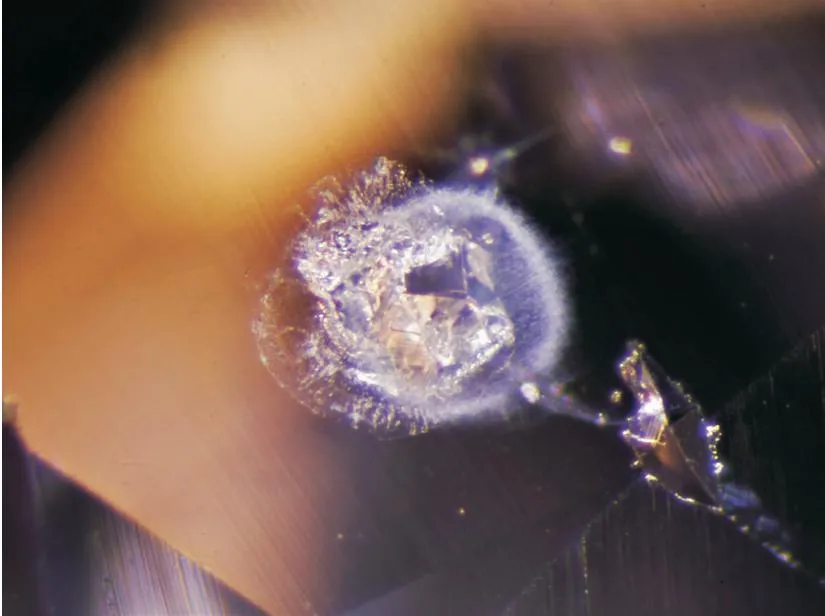
Fig.6 Irregularly shaped,cavity companied by a grayish white aureole and delicate healed fissures
Quite common are tiny,short,very delicate needles/tubes that are “attached” to the surface of the octahedral.They can be oriented perpendicular to the cavity surface or show in different directions).Malsy and Klemm (2010) describe octahedra that are penetrated by a needle-like crystal.
Most octahedra contain a poly-crystalline mineral filling and/or crystals of variable size,shape and nature.Sometimes crystals (e.g.black-opaque “graphite platelets”) are attached at the surface of the octahedral cavities.
GrowthStructures
Pronounced growth structures were not observed in any of the examined Sri Lanka spinels.
CHEMICAL FINGERPRINTING
The chemical properties of spinels originating from various locations (especially those situated in the SE-Asian ruby belt) have been published by different authors.Peretti et al.(2015) found the trace elements Li and Be in natural spinels from different origins.The elements Si,Ti,V,Cr,Zn and Ga are highly variable,and were detected in many natural spinels as well as in synthetic spinel from Russia (except Zn).
In the spinels from Myanmar,Vietnam and Tajikistan,analyzed by Malsy and Klemm (2010),the elements V,Cr,Fe,and Zn were commonly present in the highest concentrations,whereas Ti,Ga,and Mn contents were generally low.Traces of Li,Be,Co,Ni,Cu,Zr,and Sn were detected,but other investigated elements were below the detection limit.
Gorghinian et al.(2013) found the following foreign element contents in 13 red spinels from the Ratnapura mining area[in wt.%]:TiO2= 0.00 to 0.15; V2O3= 0.07 to 0.90; Cr2O3= 0.34 to 1.35; FeO = 0.05 to 0.20; Ga2O3= 0.02 to 0.10; ZnO = 0.07 to 1.23.

Table 2 Chemical fingerprinting of the spinels examined for this study using EDXRF-data wt/%
Table 2 illustrates the chemical fingerprinting of the spinels examined in this study using EDXRF-data.The table is structured considering the four locations and four color groups (pink-to-red,orange,purple-to-violet,blue-to-green).
The following elements are discussed in detail:vanadium,chromium,iron and zinc.The lower limit for the element gallium in Sri Lanka spinels is about 0.01 wt.% Ga2O3.The upper limits measured were 0.05 wt.% for Eheliyagoda,0.06 wt.% for Horana and Okkampitiya and 0.08 wt.% for Ratnapura spinels.
The manganese content is often below the detection limit in Sri Lanka spinels,and the upper MnO limits found were 0.05 wt.% for Eheliyagoda,0.10 wt.% for Horana,0.11 wt.% for Okkampitiya,and 0.07 wt.% for Ratnapura.
Fig.7 shows the correlation diagram Cr2O3vs.V2O3for pink-to-red and orange Sri Lanka spinels; Fig.9 gives the correlation diagram Fe2O3vs.Cr2O3for purple-violet and blue-green Sri Lanka spinels.

Fig.7 Correlation diagram Cr2O3 vs.V2O3 of red-pink and orange Sri Lanka spinels
Fig.8 shows the distribution pattern of the analyzed samples in the Cr2O3vs.Fe2O3diagram.In most Sri Lanka spinels,the hercynite component (Fe2O3) is dominant,and chromium contents higher than 0.4 wt.% Cr2O3are rare.
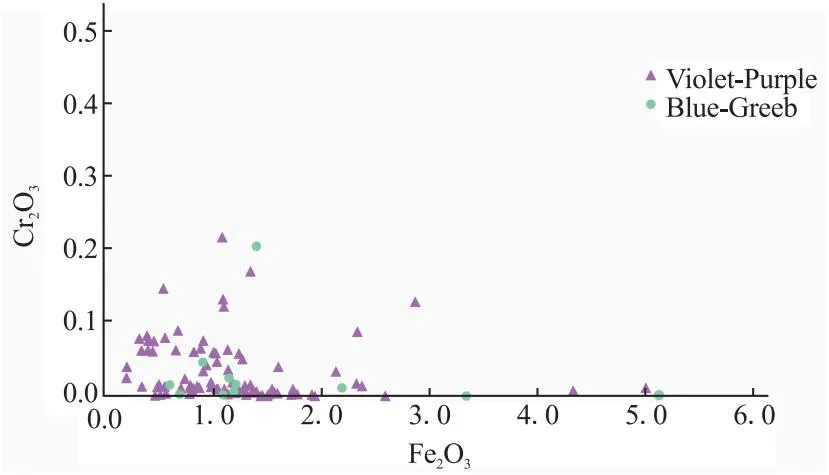
Fig.8 Correlation diagram Fe2O3 vs.Cr2O3 for purple-violet and blue-green Sri Lanka spinels
V2O3vs.Fe2O3(Fig.9) clearly shows that “high” vanadium contents (>ca.0.2 wt.% V2O3) are observed only in spinels with a “low” hercynite component ( Fig.9 Correlation diagram of Fe vs.V in the concentration range 0-2 wt.% Fe2O3 resp.V2O3 for Sri Lankan spinels Iron shows a large variation (up to c.5 wt.% Fe2O3) in the examined Sri Lanka spinels and many contain a high hercynite component.Chromium is present mostly in low-medium concentrations ( Fig.9 shows the correlation diagram V vs.Fe.It is interesting to see that vanadium contents higher than ca.0.2 wt.% V2O3were found only in spinels with Fe2O3contents less than ca.0.5 wt.% Fe2O3. The same behavior (however less pronounced) is valid for chromium:Cr2O3higher than ca.0.4 wt.% was observed only in spinels with Fe2O3<0.5 wt.% About 40 spinels from different Sri Lankan deposits were analyzed using LA-ICP-MS.Preliminary correlation diagrams designed for different combinations of the elements Li,Be,Ti,Mn,Co,Ni,Cu,Ga and Sn did not show any mining area specific trends for the population fields. UV-Vis-NIRAnalysis In Fig.10,the representative UV-Vis-NIR absorption spectra for pink-to-red,orange,purple-to-violet and blue-green Sri Lanka spinels are shown.They are combination spectra with variable ratios of the spectral components Cr3+,V3+and Fe2+. Fig.10 Representative UV-Vis-NIR spectra of spinels of different colors from Sri Lanka Detailed studies on the color and absorption behavior of spinels from Burma,Vietnam and Tajikistan were published by Malsy et al.(2012) and Huong et al.(2012).Peretti et al.(2015) distinguished three color groups (purple to green,brown or orange-red,pink to vivid red) to describe and compare Burmese spinels from Mogok and Namya. Malsy and Klemm (2010) gave the following assignments of absorption bands (based on literature data and general principles of ligand field theory).Absorption maxima at about 410 nm and 540 nm are attributed to Cr3+and maxima at 391 nm and 558 nm to V3+at octahedral sites.Since natural spinels usually contain both elements,a superposition of the individual absorption is present (“mixed Cr-V spectra”). Purple spinels with dominant amounts of iron showed absorption maxima at 372,387,457 nm and 544 nm.Their investigations by Mössbauer spectroscopy indicate Fe2+at tetrahedral sites responsible for these maxima,except a broad band at 544 nm,which results from superimposition of Cr and Fe. Gorghinian et al.(2013) concluded from their study of thirteen red spinels from the Ratnapura area that the red color of spinel is due to a combination of several chemical factors,rather than to one single chromophore,as previously believed,namely Cr.The red color essentially derives from the random iso-valent substitution of Al by[Cr + Fe + V],while V in excess contributes to hue through Frenkel defects based on the hetero-valent substitutions of 2 Al by[Zn + V]. LA-ICP-MS analyses of five Sri Lanka “cobalt-blue” spinels showed a variation of 11 to 120 ppm of this color-causing element.The Co2+absorption spectrum (Fig.11) was taken from a sample containing 120 ppm Co.Distinct Co-absorption spectra can be expected in samples with a cobalt concentration as low as about 10 ppm. Fig.11 UV-Vis-NIR absorption spectrum of a cobalt-colored Sri Lanka spinel FTIRAnalysis A random selection of around 70 samples was tested for heat treatment using FTIR spectroscopy.All samples showed no indications for heat treatment. RamanSpectraAnalysis A random selection of around 70 samples was tested for heat treatment using Raman spectroscopy.All samples showed no indications for heat treatment. Research on over 340 Sri Lankan spinels has shown that the popular pink orange series spinels have similar UV-Vis absorption spectra,but EDXRF analysis results show that red-pink spinels tend to have more Cr and less V; Once the content of V element increases,the sample tends to present an orange color tone; The cobalt content in the precious cobalt blue spinel varies from 11 to 120 ppm,and obvious characteristic absorption of Co2+and Fe2+can be seen in the UV-Vis spectrum.Other chemical elements did not show significant differences between different mining areas in Sri Lanka. The spinel characteristics of multiple mineral sites in Sri Lanka are more reflected in the inclusions and its combination.Several mining areas generally have inclusions such as dolomite,apatite,zircon,and chondrodite.Minerals such as graphite and forsterite are also found in spinel produced in the Horana region; graphite and rutile have been found in spinel produced in the Okkamptiya region.Partially healed fissures are most common in spinel in the Okkampatiya mining area; Unlike Vietnamese spinel,dislocations and growth structures are almost absent in Sri Lankan spinel. The authors would like to thank the ICA GemLab,for carrying out the analyses,photos and general documentation.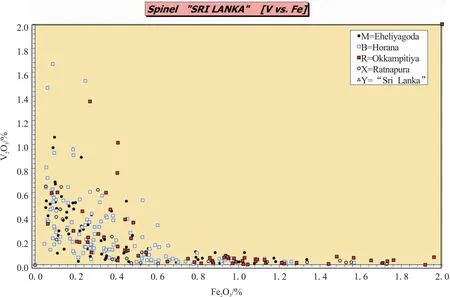
SPECTRAL FINGERPRINTING
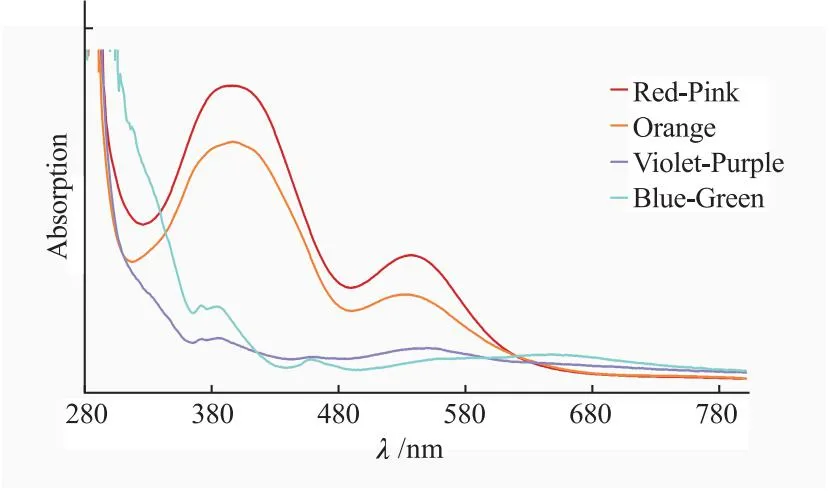
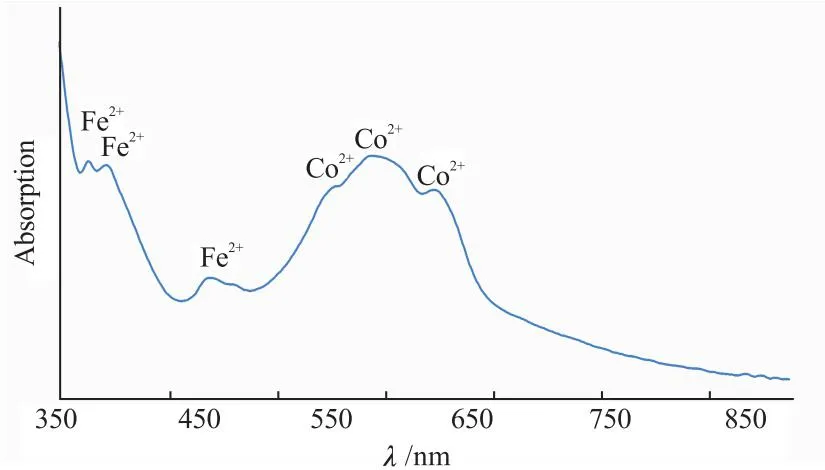
CONCLUSION
ACKNOWLEDGMENTS

